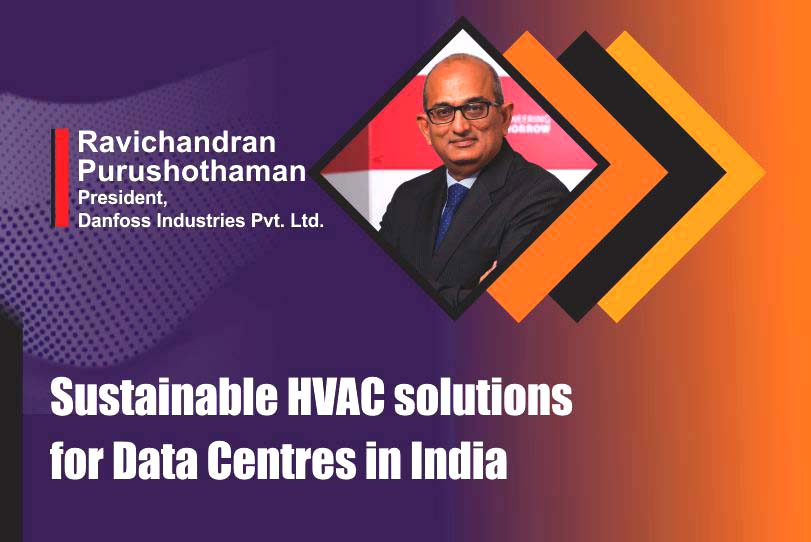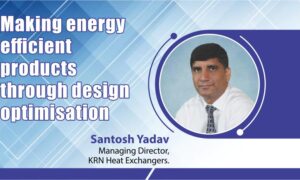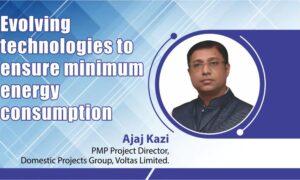Condition based monitoring is another useful tool that can meet the sustainability and reliability demand.
India has witnessed a steep rise in consumption of data from online platforms due to the stay-at home guidelines set in place due to the pandemic. The speed at which information is available from Google, YouTube searches and cloud services are at less than a second on the internet. These sources of information appear from a large collection of servers called ‘Data Centres’. However, this is just the tip of the iceberg. Ravichandran Purushothaman, president, Danfoss remarks, other than delivering material at high speeds, data centres are a physical space where powerful computers are installed to run an organisation’s services. These computers are responsible for storing, managing, and disseminating data. Information is then processed and made available to the public.
Rise of Data Centres in India
A recent study conducted by Cushman and Wakefield discovered that a sum of 11.4 billion dollars has been set aside for the development of data centres in India. Investments of this magnitude convey that the country has become an axis for growth opportunities and is fast becoming a market leader in this space. To ensure that data can be accessed at high speeds at all times, the machines in these centres need to be regulated with optimal temperature and air quality to reduce thermal throttling of electronic equipment. Any increase from ideal temperatures may result in equipment malfunction and impact the effectiveness of online operations. On the other hand, a decrease from the ideal temperature will result in sub-optimal energy consumption. Today, sustainable HVAC solutions are crucial to maintain temperature control and air quality, while reducing the negative effects on the environment.
Power Consumption and Efficiency
The current power capacity for data centres is at 375MW in India and is expected to triple by 2025. The energy capacity requirement for the future data centres underscores the need for energy efficient solutions. Power Usage Effectiveness (PUE) is a unit used to measure data centre power consumption performance. By the laws of physics, it is a well-known fact that no machine is 100 percent efficient. In an ideal world, data centres and their ancillary equipment such as HVAC systems should operate at a PUE of 1.0, which implies 100 percent efficiency. This would mean that all the power consumed would only be used on IT equipment and there is no waste heat produced from operations. In reality, the PUE was reported to be 1.58 in 2020 and only marginally better for the last 7 years. This implies that there is a lot of energy that is wasted as heat, which needs to be cooled for achieving the best performance.
To meet the overall efficiency goals of the data centre ecosystem, increasing the efficiency of HVAC systems will play a key role. The cooling requirements for these data centres depend on the site size, location, and architecture. These cooling solutions must facilitate appropriate thermal conditions and optimise the overall PUE, thereby leading to lower energy consumption and minimal CO2 emissions. To achieve better cooling efficiency, HVAC systems employ components such as cooling terminals, close control units, air-handling units etc. that are highly reliable and also reduce overall cost of ownership.
Impact on Carbon Footprint
Efficiency and reliability of HVAC systems not only impact costs but also the environment in a huge way. From the sources of energy used to the operational architecture, these systems can be optimised to make them much more sustainable. Current cooling technologies adopted in data centres use sustainable sources of energy like wind and solar, and low global warming potential refrigerants that do not harm the environment, in case of a leak. Other technologies such as condition-based monitoring and optimal temperature control have helped in keeping emissions low.
At Danfoss India, we build optimal temperature controllers using variable speed technology, like Reciprocating inverter – VTZ, to keep the data centres at an appropriate temperature even during peak load. For instance, when a server in a data centre experiences request overload, that particular server starts to work at increased capacity which produces excess heat. These HVAC systems are capable of detecting this rise in heat and start to operate at lower temperature only during such times to maintain optimal cooling for the overall data centre. This would mean the HVAC system does not draw full load at all times indicating lower energy consumption.
Condition based monitoring is another useful tool that can meet the sustainability and reliability demand. Several sensors throughout the HVAC system continuously monitor the health of all the components. In the event of deterioration in the performance, a targeted approach to resolve the issue can be undertaken by finding the exact root of the problem. This decreases downtime and replaces older inefficient parts much before the equipment fails. This leads to an improvement in the overall efficiency of the system.
Sustainable HVACs of the Future
Future HVAC systems would rely highly on artificial intelligence and machine learning to proactively predict failures and efficiency losses well in advance and start triggering corrective actions for the same. The use of ML and AI algorithms would therefore drastically reduce down-time and increase energy efficiency, thereby making them an extremely sustainable alternative.
Integrated smart energy storage devices are another area of interest since renewable sources of energy that are energy neutral; usually produce un-reliable intermittent power supply. These smart energy storage devices also distribute energy efficiently during peak-load conditions so that the total system can operate at very low average power. With these energy storage devices, sustainable sources of energy like wind and solar energy can become a very viable option for powering data centres of the future.
I believe that India’s data centres in the future are going to be large energy consumers with the amount of data created and consumed every day. But with the technologies available to us today, like Danfoss’s solutions that include the Turbocor® line up of compressors, and with the developments in the R & D space, it’s not too long before the data centres of the future achieve net carbon neutrality. These technologies therefore contribute to a cleaner, greener and energy efficient India.
Cookie Consent
We use cookies to personalize your experience. By continuing to visit this website you agree to our Terms & Conditions, Privacy Policy and Cookie Policy.















